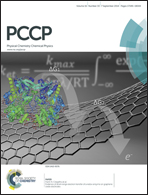The atmospheric oxidation mechanism of 1,2,4-trimethylbenzene initiated by OH radicals†
Abstract
The atmospheric oxidation mechanism of 1,2,4-trimethylbenzene (1,2,4-TMB) initiated by OH radicals is investigated using quantum chemistry calculations at M06-2X and ROCBS-QB3 levels. The calculations show that the initiation of the reaction is dominated by OH addition to C1, C3 and C5 to form 1,2,4-TMB-OH adducts R1, R3, and R5 with branching ratios of 0.22, 0.19, and 0.38, respectively, using ROCBS-QB3 energies. In the troposphere, the adducts react with O2 by irreversible H-abstraction to form phenolic compounds and by reversible addition to TMB-OH-O2 peroxy radicals, which will cyclize to bicyclic radicals, similar to those in benzene, toluene, and xylenes. The bicyclic radicals can further recombine with O2 to generate bicyclic peroxy and alkoxyl radicals. The bicyclic alkoxyl radicals would break the ring directly to form 1,2-dicarbonyl products and unsaturated 1,4-dicarbonyl co-products, or undergo another cyclization to form an epoxy group, followed by the ring-breakage to form 1,2-dicarbonyl products and epoxy-1,4-dicarbonyl co-products. The predicted yields of products agree reasonably with the previous experimental measurements, while considerable discrepancies also exist for the yields of nitrates, biacetyl, 4-oxo-2-pentenal, and butenedial, etc. Our mechanism also predicts a new type of epoxy-1,4-dicarbonyl compounds with a total yield of ∼0.32. The epoxy-1,4-dicarbonyl compounds have not been suggested or reported in previous studies.


 Please wait while we load your content...
Please wait while we load your content...